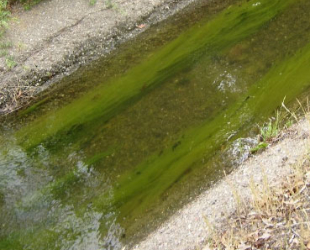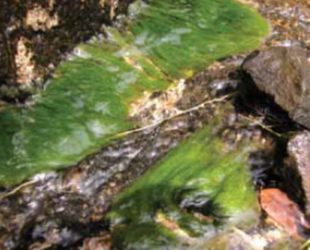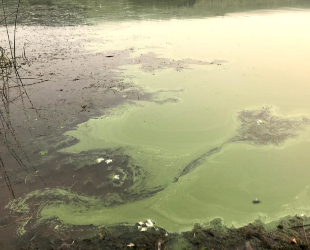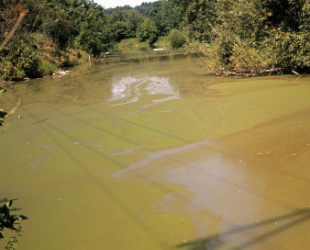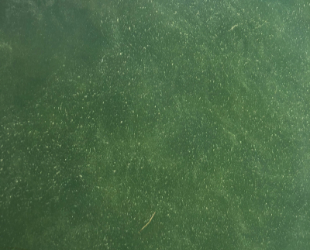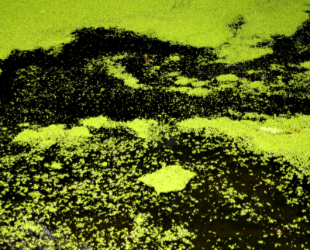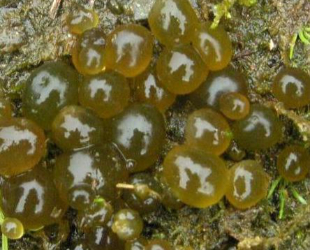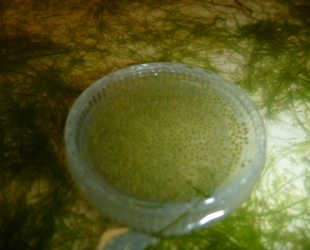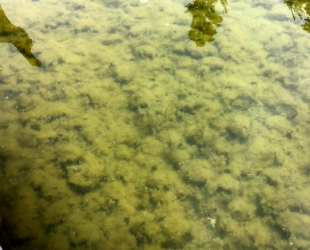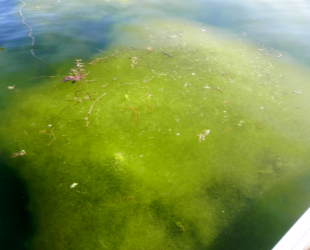How to recognize an algae bloom
Algae blooms come in many shapes and sizes, and harmful cyanobacteria blooms can look very similar to harmless algae blooms.
The only way to definitively identify a cyanobacteria or algae bloom is through microscopic analysis of cells at a certified laboratory. However, the following guide provides some basic guidance on recognizing and describing algae blooms.
First, determine whether the algae bloom type is filamentous or planktonic
You can do this with a simple finger test (or you can use a stick). Wearing gloves, scoop up a handful of the bloom and let the water drain between your fingers.
Which image below most resembles the bloom you observed?
If "long stringy masses" are left on your hand,
it is filamentous algae.
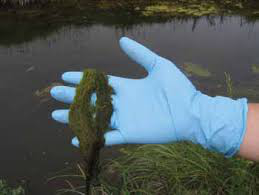
If only "small bits" are left on your hand,
it is planktonic algae.
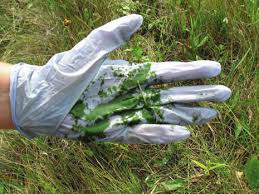
Second, find the descriptor that best defines what you are looking at
Once you have determined whether the bloom is filamentous or planktonic, use the identification table below to help determine the best descriptor for the bloom.
How to use the identification table
The table contains photo examples and descriptions of algal species that cause common algal blooms in B.C.
Some algal blooms may produce cyanotoxins (refer to "cyanobacteria bloom" column) and others do not (refer to "other algae bloom" column).
Review the photos and descriptions to help you determine which ones best fits what you are looking at and use this information to submit your observation to us.
| 1) Filamentous algae | Cyanobacteria bloom | Other algae bloom |
|---|---|---|
|
|
Descriptor option A: "Looks like stringy or net-like" (see example images below) |
|
|
More details about Oscillatoria:
|
More details about Cladophora:
|
|
| 2) Planktonic algae | Cyanobacteria bloom | Other algae bloom |
|---|---|---|
|
If you have observed a planktonic bloom, look to the right columns for further guidance on recognizing cyanobacteria versus algae. Then choose the appropriate descriptor option. As an example, for this algae bloom type, you could determine that you have:
|
Descriptor option B: "Looks like pea soup or paint-like" (see example images below) |
|
|
More details about Anabaena:
|
More details about Euglena:
|
|
| Cyanobacteria bloom | Other algae bloom | |
| or descriptor option C: "Looks like grass clippings" | ||
|
More details about Aphanizomenon:
|
More details about Chlamydomonas:
|
|
| Cyanobacteria bloom | Other algae bloom | |
| or descriptor option D: "Looks like globular or bead-like" | ||
|
More details about Nostoc:
|
More details about Volvox:
|
|
| Cyanobacteria bloom | Other algae bloom | |
| or descriptor option E: "Looks like fluffy or pom-pom-like" | ||
|
More details about Gloeotrichia:
|
More details about Spirogyra:
|
|
Please  remember
remember
If you suspect a cyanobacteria bloom on your water body, visit our cyanobacteria (blue-green algae) page and HealthLinkBC for more information.
...previous topicWhat causes an algae bloom? |
next topic... |
Image references
(1) Algae identification - field guide : an illustrative field guide on identifying common algae found in the Canadian prairies / [by] Nancy Serediak and Mai-Linh Huynh. URL: http://publications.gc.ca/site/eng/9.694442/publication.html
(2) Source: http://waterfeaturepros.com/pond-algae/oscillatoria-algae/
(3) Photos from B.C. Ministry of Environment and Climate Change Strategy staff files
(4) Source: http://www.downgardenservices.org.uk/bluegreenalgae.htm
(5) Source: https://www.britannica.com/science/Euglena
(6) Source: https://garden.lovetoknow.com/garden-basics/aquatic-plants/pond-algae
(7) Source: https://flisteward.com/2012/06/14/stewards-keep-eye-out-for-algal-blooms/

